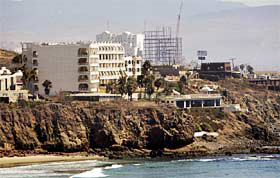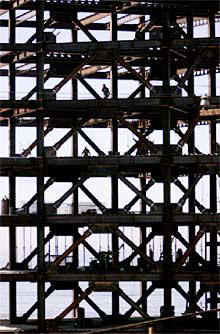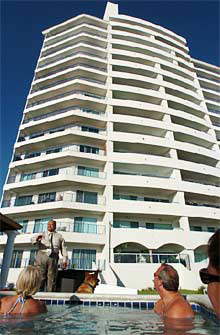 |
 |
 |
 News Around the Republic of Mexico | October 2005 News Around the Republic of Mexico | October 2005  
Mexican Coastal Areas Experiencing a Surge in Housing Construction
 Sandra Dibble & Lori Weisberg - Union-Tribune Sandra Dibble & Lori Weisberg - Union-Tribune


| | A new tower rises along the Baja California coast in Roasarito Beach. The tourist-oriented city is the hub of a development boom stretching from Tijuana to Ensenada that has been fed by U.S. demand for coastal property. (Photo: Don Kohlbauer) |
Step out onto the balconies of the newest condominiums rising along the Pacific Ocean and catch colorful sunsets, misty mornings, dolphins leaping from the waves – and giant cranes lifting steel beams for a new tower next door.

It's boom time on the Baja California coastline as U.S. buyers seduced by dramatic ocean views and bargain prices snap up properties from Tijuana to Rosarito Beach to Ensenada.

Bulldozers break the quiet of once-sleepy coastal stretches. Clients stream through construction sites and model homes, putting down tens of thousands of dollars before buildings are even off the ground. U.S. real estate agents, developers, lenders and title insurance companies are setting up shop, eager to capture a share of the business.

"The telephone has been ringing off the hook for every real estate agent in this town," said Diane Gibbs, a longtime agent in Rosarito Beach, a rapidly growing community of 135,000 people where much of the new development is taking place.

A unique set of cross-border circumstances has converged on this coastal strip to heat up the market: skyrocketing real estate prices in the United States, improved investment safety in Mexico because of the increasing availability of title insurance and escrow accounts, and reluctance among growing numbers of U.S. travelers and investors to venture far from home after the Sept. 11, 2001, terrorist attacks.


| | Baja coastal development is a mix of low- and high-rise projects, with units generally priced between $200,000 and $500,000. (Photo: Don Kohlbauer) |
While the vistas may rival those of La Jolla or Carmel, the reality is that buying in Mexico isn't real estate U.S.-style. Foreigners are barred from directly owning residential property along the coast, and boundary disputes abound on the Baja California peninsula. While good deals can be found, so can potential problems.

Still, with ocean-view homes in California priced at stratospheric levels, investing in Baja California has become an affordable way for many U.S. citizens to fulfill their dream of owning beachfront property.

More and more are drawing equity from their primary homes in the United States to finance second homes in Mexico. Once viewed as a quiet spot to retire, camp or leave a trailer, the coast is drawing an increasingly younger and wealthier U.S. clientele.

"It's the whole idea of being in a foreign country, and still close," said Todd Glimme, 42, of San Diego.

Tapping into equity from their home in Clairemont, Glimme and his wife, Leslie McLaughlin, put nearly $100,000 down on two $277,000 condominiums under construction in Rosarito Beach.

They plan to sell one at a profit. They will keep the other, eventually commuting between Mexico, where he is starting an information technology business, and San Diego, where she works for the Navy.

"To buy a place the equivalent of that up here, you'd be paying in the millions," Glimme said.

The region has been a haven for U.S. expatriates for decades. Shops, restaurants and services cater to English-speaking, dollar-carrying consumers. But for all the trappings of home, this is a foreign country.

The Mexican Constitution bans foreigners from owning coastal residential property, so most oceanfront buyers hold title as beneficiaries of long-term trusts through a Mexican bank. Financing is more difficult and expensive, and required down payments can be as large as 50 percent of the purchase price. Real estate agents are not licensed as they are in the United States, and they have no legal obligation to disclose potential problems with a property.

"When Americans go to Mexico, they should do their due diligence," said Jorge A. Vargas, a specialist in Mexican law at the University of San Diego. "You are entering an alien legal world, so don't be so trusting with people. The conveyance of property is completely different from the American system."

The Baja California peninsula can be particularly problematic. Many parcels suffer from lingering land title disputes, which are a legacy of the region's distance from Mexico's ruling center and decades of little development. Inaccurate land surveys are only now being corrected as parcels are being developed and sold.

"There are a lot of issues dealing with conflict of title all along the coast from Tijuana to Ensenada," said attorney José Larroque, with the Tijuana office of Baker & McKenzie, an international law firm. "For many years, these properties were vacant. Now that they're being developed, all these owners pop up."


| | Essam Self (standing) a retired physician from Orange County, bought two condominiums at the La Jolla de Rosarito development in 2004. He has since persuaded seven friends and one family member to buy in Rosarito Beach as well. (Photo: David Maung) |
Buyers have ended up on land with multiple titles, or without services or have built in the restricted federal maritime zone. A mistake can take years to correct.

Without proper precautions, "this boom can create a new wave of problems," said Silvia Perez-Thompson, a real estate consultant in Rosarito Beach. "I think it's a great investment, but you have to understand the laws."

Thousands Of Units

Baja California tourism officials tally 24 major projects under way in the Tijuana-Rosarito corridor with a total of 2,800 units, but other projects in the pipeline would easily double that figure. In Rosarito Beach alone, city officials count more than 600 units under construction and more than 700 in the planning phase.

Interest has spread south to Ensenada, where developers of Ventana al Mar are proposing 2,500 units on 611 acres; just up the coast, at Bajamar, a development group is preparing to propose an adult master-planned community with 2,500 homes and a nine-hole golf course. An additional dozen projects with 1,200 units are under way across the state in San Felipe.

The projects along the coast south of Tijuana are a mix of low-and high-rise developments, with units generally priced between $200,000 and $500,000.

Researchers, environmentalists and residents warn that the rapid growth is something that must be cautiously managed. Left unchecked, development could jeopardize the very scenery that draws so many to the region.

The new developments also pose challenges for state and local governments that must supply services to keep up with the growth. "We must run with the market; otherwise we'll have bottlenecks in the next year, water, waste disposal, sewage, water treatment," said Diego Moreno, director of urban development for Rosarito Beach.

The surge in sales follows years of stagnation and false starts on the Tijuana-Ensenada corridor.

"This was always known as the corridor of broken dreams," said David Ellsworth, a longtime consultant who once worked with the Mexican government's tourism development agency, Fonatur. "You saw so many entryways that got built and nothing happens. There were more failures than successes."

The market was hit hard after the widely publicized, court-ordered evictions of more than 200 U.S. citizens at Punta Banda, outside Ensenada. Caught in the middle of a long-standing coastal property dispute between a communal landholding group and private owners, they were forced to leave when the land was restored to the private landowners.

But nearly five years later, Punta Banda seems a distant memory.

In downtown Rosarito Beach, Gustavo Torres' eyes dart between his computer and the potential clients stepping through his office door on a busy Saturday morning. In June 2004, his business sold seven properties; last June, it sold 49, and values are going up quickly.

"Two years ago, you could find a nice oceanfront home for $220,000," Torres said. "Now they are selling for $580,000."

A few miles down the coast, Diane Gibbs and her team operate from an ornately decorated, wood-paneled office in a small strip mall that includes a piano, a bar, a grandfather clock and a sign that reads, "Dream." The Missouri native has been selling property in Baja California since the late 1980s and says she has learned to read her U.S. clients.

"I can have somebody in my car 15 minutes and know if they're going to make it in Mexico or not," said Gibbs, steering her Mercedes sedan through a construction site near her office one recent afternoon. "Just by the questions they ask: 'Well, what about this trash on the side of the road? What about these junk cars?' "

Gibbs and others say a significant chunk of the market is Mexican-American, but many of those buyers purchase lower-priced lots east of the coastal road. Those who are Mexican citizens can hold title directly, avoiding the bank trusts, or fideicomisos required of foreigners buying along the coast.

Some developers are seizing on U.S. Latinos' growing purchasing power. One is planning an oceanfront adult community near Ensenada marketed pri marily at Southern California Latinos. And at least one real estate agent has seen growing numbers of Mexican-American clients for the more expensive oceanfront homes over the past year.

"The increase has been remarkable," said Gustavo Torres, who said Mexican-Americans now account for nearly 30 percent of sales.

Often, those who decide to buy say they are motivated by more than Mexico's affordable prices. They talk about the laid-back lifestyle and the kindness and civility of Mexicans they encounter.

"It's the warm feeling here," said Essam Seif, a retired physician from Orange County, who has bought two condominiums at La Jolla de Rosarito and has encouraged friends and relatives to join him. "Even though I don't know the language, it's very easy to understand people and communicate."

Baby-Boom Money

A large part of the demand in Baja California comes from California residents such as Seif, who say they like the proximity to the border. Developer Eduardo Chabert, who is planning his fifth condominium development in Rosarito Beach, said nearly all of his buyers are from Southern California, with 70 percent of them U.S. born and 20 percent Mexican-born U.S. residents.

Resorts across Mexico are experiencing a surge in U.S. buyers, from Cancun to Cabo San Lucas and Puerto Peñasco to Puerto Vallarta. Ellsworth, the tourism consultant, attributes the spike in interest to a range of factors, including the stability of the peso in recent years and the increasing availability of title insurance, a form of protection for buyers should problems arise over issues such as ownership or unpaid taxes.

Along the Tijuana-Ensenada corridor, interest in buying property has skyrocketed over the past year, after the region was the subject of a favorable CBS News report, "The American Dream in Mexico," that has aired three times since May 2004; it is now featured prominently in literature and on Web sites promoting the region.

Alex and Diane Piagnarelli, both 50, watched the report in June from their home in a Chicago suburb. They had vacationed in Mexico, but never in Baja California, and began investigating the area through the Internet. A month later, they were driving past palm trees and bougainvillea, stepping into condos with travertine tile floors, granite counter tops, Jacuzzi tubs and floor-to-ceiling views of the Pacific Ocean.

The Piagnarellis wanted to use the equity from their home to buy a place where they could spend vacations and eventually retire together with Diane's sister, Pat, and her sister's husband, Bob Evans.

After three days of touring, the two couples settled on a $426,000, three-bedroom, 2½-bath house with an ocean view in Las Ventanas, a 47-unit community being developed by a Irvine-based company.

With the proper precautions, the risk of buying in Mexico is minimal, say attorneys and real estate specialists. But in their zeal to catch the wave of price appreciation along the Baja California coast, some buyers may take unnecessary risks that put their investments in jeopardy, some real estate experts say.

They buy properties, for example, where the title is in dispute. Or they put a sizable amount of money down long before their unit is completed, without holding the money in an escrow account or demanding a performance bond in case the project is not completed. And some forgo title insurance, even though it is increasingly available.

"It's surprising that they don't use common sense," said Rafael Gama Pérez, a Tijuana attorney who frequently represents U.S. citizens buying coastal property in Baja California. "The most common problem is that people come for a weekend, they see an advertisement, they get excited, they sign a document and put down $5,000 or $10,000. Only later do they realize the commitment they've made, and when they change their mind, it's too late."

In at least one case, U.S. investors have bought condos in a housing project where they knew they could not get a bank trust because the developer didn't yet have the necessary approvals for his project.

Looking Past Problems

Steve Rockman, a 51-year-old psychologist from Dana Point, looked south after finding oceanfront land in California beyond his means. He says he fell in love with the Costa Bella development the moment he set foot on the beachfront property in Rosarito Beach. The project, however, has had a problem because buyers are unable to obtain title or bank trusts on the units.

Costa Bella developer Saul Flores said his company is working diligently to secure the approvals he needs from the city of Rosarito so that bank trusts can be issued to individual buyers. He said approvals have been delayed because he redesigned his newest tower to accommodate the tastes of U.S. buyers he is hoping to court. He also acknowledges that for years there had been a large debt that left a lien on the property, which Flores said he has now paid off, and that only a small secondary debt remains.

Rockman took one precaution before putting down nearly $100,000 on a 2,800-square-foot unit that will cost $325,000. He contacted a Mexican attorney who told him there was little chance the deal would fall through.

"We know we're taking a risk, but it's a calculated risk," Rockman said. "Once they get title, I think these places will go up tremendously."

Not everyone who has considered buying in Mexico has come away enchanted with the prospect of foreign ownership.

Laura Dietterle went this year with her husband on a Baja California bus tour sponsored by Coldwell Banker Alliance Real Estate. The Rancho Peñasquitos couple concluded that the investment was too risky.

"Maybe I'm just too cautious," she said. "I'm sure there will be people who will buy and be very happy, but I'm just not one of them."

Even as more developments rise, there are more customers than supply. Fierce competition can erupt among developers and real estate agents jockeying for listings and trying to make sales while the market is still hot.

The intensity can fuel confusion among buyers venturing for the first time into Mexico. Hugo Torres, former mayor of Rosarito Beach and head of the town's main business group, has been calling for clear rules so investors can feel safe.

Torres, who has been a partner in several developments, proposes reforming state laws so title insurance is available to anyone who wants it and mandating a U.S.-style escrow system for any transaction. Torres is also calling for new rules that would ban the sale of properties that don't have all the required city permits.

But those reforms could take time. Meanwhile, builders and sellers are starting to police themselves through codes of ethics and associations.

"If we don't make changes as soon as possible, we're going to have the possibility of something going wrong," said Torres, owner of the Rosarito Beach Hotel.

Though Torres has been a strong advocate of title insurance, his former partner, Eduardo Chabert, has only recently embraced the idea.

"We haven't seen the necessity," said Chabert, a developer of resorts across Mexico. "What we sell is our prestige. We haven't had a single problem."

Last week, Chabert provided a copy of a policy issued by First American Title Insurance Co. to his firm, Desarolladora de las Californias, insuring the land beneath his latest Rosarito project, La Jolla Real, for $200,000.

Desarolladora de las Californias has been granted city permits to develop the property and is building an adjoining condominium project that doesn't have title insurance but is nearly sold out. The land beneath that project, La Jolla del Mar, remains the subject of a lawsuit – filed years before the company bought the property – by Tomás Corona, who alleges that his constitutional rights were violated when an agrarian court ruled in 1999 that a local land cooperative, the Ejido Mazatlan, was the legitimate owner.

The crush of development proposals is keeping inspectors and planners busier than ever at Rosarito Beach City Hall.

Moreno, the urban development director, sits in his first-floor office surrounded by plans and sketches of proposed communities, fielding queries from architects, engineers, developers.

"Everybody wants a piece of the cake," Moreno said. "This is a process that's just beginning." | 
 | |
 |



